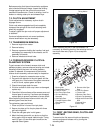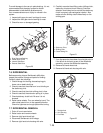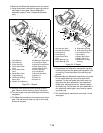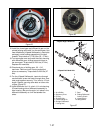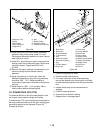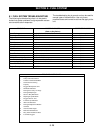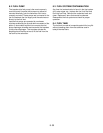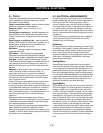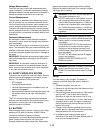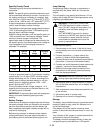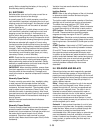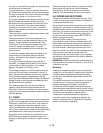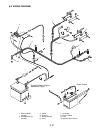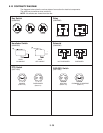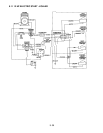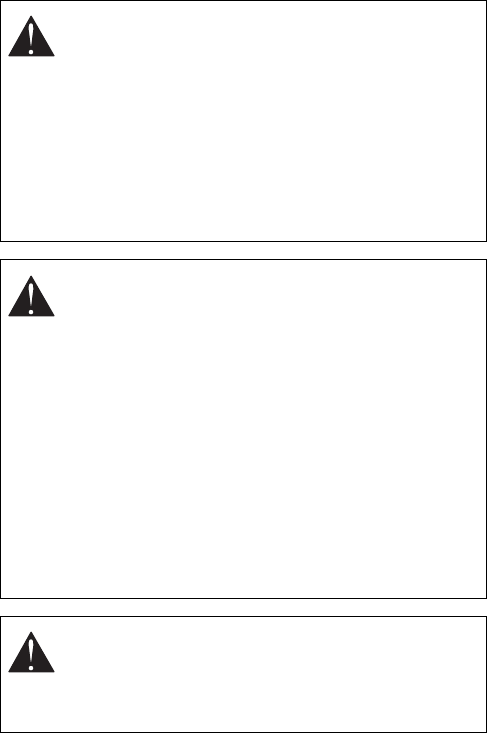
9 -32
Voltage Measurement
There are two basic rules to be remembered when
using a voltmeter. A voltmeter measures the voltage
difference between the test leads and the voltmeter is
always connected across the circuit under test.
Current Measurement
The two rules to remember when measuring current
with an ammeter are; an ammeter measures the cur-
rent that flows through the meter, and to measure cur-
rent an ammeter must be connected into the circuit.
The latter rule means that the circuit must be opened,
and the ammeter wired into it. Because this procedure
is usually difficult, an ammeter is seldom used for trou-
bleshooting.
Resistance Measurement
An ohmmeter is used to make resistance measure-
ments and to check continuity through wires and elec-
trical components.
There is one rule to keep in mind when using an ohm-
meter. The ohmmeter has a self contained battery and
requires no electrical power. Using the ohmmeter on a
circuit that has power applied may result in damage to
the meter.
IMPORTANT:
Disconnect the equipment battery when
making Ohmmeter test or damage to the Ohmmeter
may result.
IMPORTANT:
An ohmmeter reads the resistance of
whatever component is connected between the test
leads. It can be used to check wires, coils, light bulbs,
or any item that conducts current.
9.3 SAFETY INTERLOCK SYSTEM
The tractor has an electrical interlock system. Several
switches need to be engaged for the engine to start
and run. The switches in the system are:
• PTO Interlock
• Forward/Reverse Interlock
• Left and Right presence on handlebars (only one
needs to be engaged)
• Steering Brake Presence (Optional) electrically has
the same function as the right hand presence
switch.
The PTO, forward/reverse and one of the presence
switches must be closed for the engine to start. Once
the engine is running only one of the presence
switches needs to be closed.
9.4 BATTERY
When charging battery, remove it from unit first. Keep
batteries out of reach of children. ALWAYS follow
information provided on battery by battery
manufacturer. Lead acid batteries generate explosive
gases. Severe chemical burns can result from
improper handling of battery electrolyte. Wear safety
glasses and proper protective gear when handling
batteries to prevent electrolyte from coming in contact
with eyes, skin or clothing.
Set-Up
The new battery is dry charged. The dealer or
customer must add electrolyte (sulfuric acid and
water).
1. Remove the battery from the unit.
2. Remove all the vent caps from the battery and set
the caps to one side.
3. Take the electrolyte which should be 1.265 specific
gravity at 80
o
F, and fill each cell so that the
electrolyte is level with the bottom of the fill ring.
4. The battery should stand for 1/2 hour. Now check
electrolyte level in each cell again. If necessary
add more electrolyte to bring the level up to the
bottom of the ring.
5. Charge until all cells are gassing freely, and the
specific gravity is constant over three successive
readings taken at 30 minute intervals.
6. Immediately after charging check level of
electrolyte. If the level is low add distilled water to
bring it up to the required level.
WARNING:
ELECTRIC SHOCK may result in
injury and/or damage to unit.
DO NOT allow tools or other objects to come
into contact with both terminal at the same
time. ALWAYS remove Negative (-) Cable first
to reduce risk of sparks when removing bat-
tery. ALWAYS connect Positive (+) Cable first,
then connect Negative (-) Cable when install-
ing battery.
WARNING:
EXPLOSIVE GASES can result
in serious injury or death. ALWAYS keep open
flames, sparks, or smoking materials away
from battery.
POISONOUS BATTERY FLUID contains sul-
furic acid and its contact with skin, eyes or
clothing can cause severe chemical burns.
ALWAYS wear safety glasses and protective
gear near battery.
DO NOT TIP any battery beyond 45 degree
angle in any direction.
ALWAYS KEEP BATTERIES OUT OF
REACH of children.
WARNING:
REVERSE CONNECTIONS may
result in sparks which may result in injury.
ALWAYS connect/disconnect cables in proper
order.



